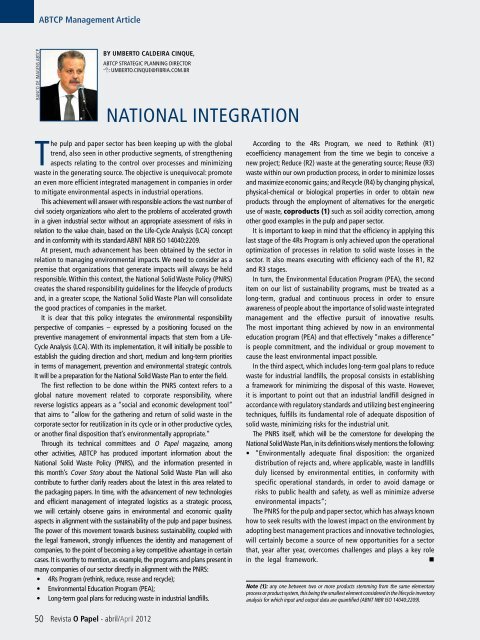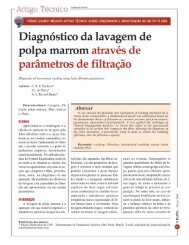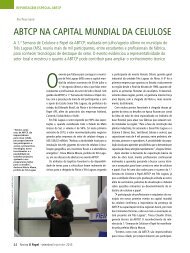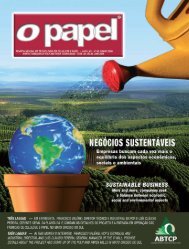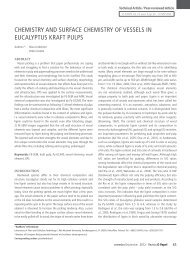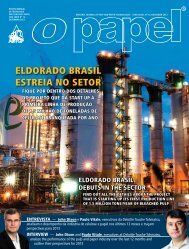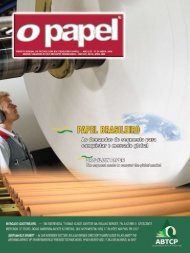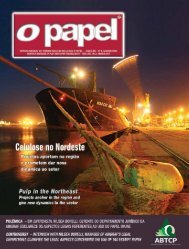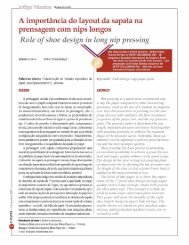PLANO NACIONAL DE RESÃDUOS SÃLIDOS - Revista O Papel
PLANO NACIONAL DE RESÃDUOS SÃLIDOS - Revista O Papel
PLANO NACIONAL DE RESÃDUOS SÃLIDOS - Revista O Papel
Create successful ePaper yourself
Turn your PDF publications into a flip-book with our unique Google optimized e-Paper software.
ABTCP Management Articlebanco de imagens abtcpBy Umberto Caldeira Cinque,ABTCP Strategic Planning Director: umberto.cinque@fibria.com.brNational integrationThe pulp and paper sector has been keeping up with the globaltrend, also seen in other productive segments, of strengtheningaspects relating to the control over processes and minimizingwaste in the generating source. The objective is unequivocal: promotean even more efficient integrated management in companies in orderto mitigate environmental aspects in industrial operations.This achievement will answer with responsible actions the vast number ofcivil society organizations who alert to the problems of accelerated growthin a given industrial sector without an appropriate assessment of risks inrelation to the value chain, based on the Life-Cycle Analysis (LCA) conceptand in conformity with its standard ABNT NBR ISO 14040:2209.At present, much advancement has been obtained by the sector inrelation to managing environmental impacts. We need to consider as apremise that organizations that generate impacts will always be heldresponsible. Within this context, the National Solid Waste Policy (PNRS)creates the shared responsibility guidelines for the lifecycle of productsand, in a greater scope, the National Solid Waste Plan will consolidatethe good practices of companies in the market.It is clear that this policy integrates the environmental responsibilityperspective of companies – expressed by a positioning focused on thepreventive management of environmental impacts that stem from a Life-Cycle Analysis (LCA). With its implementation, it will initially be possible toestablish the guiding direction and short, medium and long-term prioritiesin terms of management, prevention and environmental strategic controls.It will be a preparation for the National Solid Waste Plan to enter the field.The first reflection to be done within the PNRS context refers to aglobal nature movement related to corporate responsibility, wherereverse logistics appears as a “social and economic development tool”that aims to “allow for the gathering and return of solid waste in thecorporate sector for reutilization in its cycle or in other productive cycles,or another final disposition that’s environmentally appropriate.”Through its technical committees and O <strong>Papel</strong> magazine, amongother activities, ABTCP has produced important information about theNational Solid Waste Policy (PNRS), and the information presented inthis month’s Cover Story about the National Solid Waste Plan will alsocontribute to further clarify readers about the latest in this area related tothe packaging papers. In time, with the advancement of new technologiesand efficient management of integrated logistics as a strategic process,we will certainly observe gains in environmental and economic qualityaspects in alignment with the sustainability of the pulp and paper business.The power of this movement towards business sustainability, coupled withthe legal framework, strongly influences the identity and management ofcompanies, to the point of becoming a key competitive advantage in certaincases. It is worthy to mention, as example, the programs and plans present inmany companies of our sector directly in alignment with the PNRS:• 4Rs Program (rethink, reduce, reuse and recycle);• Environmental Education Program (PEA);• Long-term goal plans for reducing waste in industrial landfills.According to the 4Rs Program, we need to Rethink (R1)ecoefficiency management from the time we begin to conceive anew project; Reduce (R2) waste at the generating source; Reuse (R3)waste within our own production process, in order to minimize lossesand maximize economic gains; and Recycle (R4) by changing physical,physical-chemical or biological properties in order to obtain newproducts through the employment of alternatives for the energeticuse of waste, coproducts (1) such as soil acidity correction, amongother good examples in the pulp and paper sector.It is important to keep in mind that the efficiency in applying thislast stage of the 4Rs Program is only achieved upon the operationaloptimization of processes in relation to solid waste losses in thesector. It also means executing with efficiency each of the R1, R2and R3 stages.In turn, the Environmental Education Program (PEA), the seconditem on our list of sustainability programs, must be treated as along-term, gradual and continuous process in order to ensureawareness of people about the importance of solid waste integratedmanagement and the effective pursuit of innovative results.The most important thing achieved by now in an environmentaleducation program (PEA) and that effectively “makes a difference”is people commitment, and the individual or group movement tocause the least environmental impact possible.In the third aspect, which includes long-term goal plans to reducewaste for industrial landfills, the proposal consists in establishinga framework for minimizing the disposal of this waste. However,it is important to point out that an industrial landfill designed inaccordance with regulatory standards and utilizing best engineeringtechniques, fulfills its fundamental role of adequate disposition ofsolid waste, minimizing risks for the industrial unit.The PNRS itself, which will be the cornerstone for developing theNational Solid Waste Plan, in its definitions wisely mentions the following:• “Environmentally adequate final disposition: the organizeddistribution of rejects and, where applicable, waste in landfillsduly licensed by environmental entities, in conformity withspecific operational standards, in order to avoid damage orrisks to public health and safety, as well as minimize adverseenvironmental impacts”;The PNRS for the pulp and paper sector, which has always knownhow to seek results with the lowest impact on the environment byadopting best management practices and innovative technologies,will certainly become a source of new opportunities for a sectorthat, year after year, overcomes challenges and plays a key rolein the legal framework.•Note (1): any one between two or more products stemming from the same elementaryprocess or product system, this being the smallest element considered in the lifecycle inventoryanalysis for which input and output data are quantified (ABNT NBR ISO 14040:2209).50 <strong>Revista</strong> O <strong>Papel</strong> - abril/April 2012


